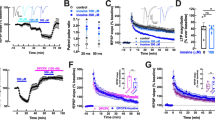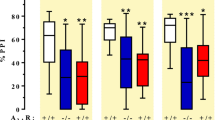Abstract
The adenosine receptor agonist 2-[p-(2-carboxyethyl)phenylethylamino]-5′-N-ethylcarboxamidoadenosine (CGS 21680) is generally considered to be a selective adenosine A2A receptor ligand. However, the compound has previously been shown to exhibit binding characteristics that are not compatible with adenosine A2A receptor binding, at least in brain regions other than the striatum. We have examined binding of [3H]CGS 21680 and of antagonist radioligands with high selectivity for adenosine A1 or A2A receptors to hippocampus and striatum of mice lacking either adenosine A1 (A1R(−/−)) or A2A (A2AR(−/−)) receptors. Both receptor autoradiography and membrane binding techniques were used for this purpose and gave similar results. There were no significant changes in the binding of the A1 receptor antagonist [3H]DPCPX in mice lacking A2A receptors, or in the binding of the A2A receptor antagonists [3H]SCH 58261 and [3H]ZM 241385 in mice lacking A1 receptors. Furthermore, [3H]CGS 21680 binding in striatum was abolished in the A2AR(−/−), and essentially unaffected in striatum from mice lacking A1 receptors. In hippocampus, however, binding of [3H]CGS 21680 remained in the A2AR(−/−), whereas binding was virtually abolished in the A1R(−/−). There were no adaptive alterations in A2A receptor expression in this region in A1R(−/−) mice. Thus, most of the [3H]CGS 21680 binding in hippocampus is dependent on the presence of adenosine A1 receptors, but not on A2A receptors, indicating a novel binding site or novel binding mode.





Similar content being viewed by others
Abbreviations
- CGS 21680:
-
2-[p-(2-Carboxyethyl)phenylethylamino]-5′-N-ethylcarboxamidoadenosine
- ZM 241385:
-
4-(2-[7-Amino-2-(2-furyl)[1,2,4]triazolo[2,3-a][1,3,5]triazin-5-ylamino]ethyl)phenol
- SCH 58261:
-
5-Amino-7-(2-phenylethyl)-2-(2-furyl)-pyrazolo[4,3-e]-1,2,4-triazolo[1,5-c]pyrimidine
- DPCPX:
-
1,3-Dipropyl-8-cyclopentylxanthine
- CGS 15943:
-
9-Chloro-2-(2-furanyl)-5,6-dihydro-[1,2,4]-triazolo-[1,5]quinazolin-5-imine monomethanesulfonate
- NECA:
-
5′-N-ethylcarboxamidoadenosine
- A1R(−/−):
-
Adenosine A1 receptor knock-out
- A1R(+/−):
-
Adenosine A1 receptor heterozygote
- A1R(+/+):
-
Adenosine A1 receptor wild-type
- A2AR(−/−):
-
Adenosine A2A receptor knock-out
- A2AR(+/−):
-
Adenosine A2A receptor heterozygote
- A2AR(+/+):
-
Adenosine A2A receptor wild-type
- RT-PCR:
-
Reverse transcriptase-polymerase chain reaction
References
Chunn JL, Young HW, Banerjee SK, Colasurdo GN, Blackburn MR (2001) Adenosine-dependent airway inflammation and hyperresponsiveness in partially adenosine deaminase-deficient mice. J Immunol 167:4676–4685
Cunha RA, Ribeiro JA (2000) Purinergic modulation of [(3)H]GABA release from rat hippocampal nerve terminals. Neuropharmacology 39:1156–1167
Cunha RA, Johansson B, van der Ploeg I, Sebastiao AM, Ribeiro AJ, Fredholm BB (1994a) Evidence for functionally important adenosine A2a receptors in the rat hippocampus. Brain Res 649:208–216
Cunha RA, Milusheva E, Vizi ES, Ribeiro JA, Sebastião AM (1994b) Excitatory and inhibitory effects of A1 and A2A adenosine receptor activation on the electrically evoked [3H]acetylcholine release from different areas of the rat hippocampus. J Neurochem 63:207–214
Cunha RA, Johansson B, Fredholm BB, Ribeiro JA, Sebastião AM (1995) Adenosine A2A receptors stimulate acetylcholine release from nerve terminals of the rat hippocampus. Neurosci Lett 196:41–44
Cunha RA, Johansson B, Constantino MD, Sebastião AM, Fredholm BB (1996) Evidence for high-affinity binding sites for the adenosine A2A receptor agonist [3H] CGS 21680 in the rat hippocampus and cerebral cortex that are different from striatal A2A receptors. Naunyn-Schmiedebergs Arch Pharmacol 353:261–271
Cunha RA, Constantino MD, Ribeiro JA (1999) G protein coupling of CGS 21680 binding sites in the rat hippocampus and cortex is different from that of adenosine A1 and striatal A2A receptors. Naunyn-Schmiedebergs Arch Pharmacol 359:295–302
Dixon AK, Gubitz AK, Sirinathsinghji DJS, Richardson PJ, Freeman TC (1996) Tissue distribution of adenosine receptor mRNA in the rat. Br J Pharmacol 118:1461–1468
El Yacoubi M, Ledent C, Menard JF, Parmentier M, Costentin J, Vaugeois JM (2000) The stimulant effects of caffeine on locomotor behaviour in mice are mediated through its blockade of adenosine A(2A) receptors. Br J Pharmacol 129:1465–1473
Fastbom J, Fredholm BB (1990) Regional differences in the effect of guanine nucleotides on agonist and antagonist binding to adenosine A1-receptors in rat brain, as revealed by autoradiography. Neuroscience 34:759–769
Fredholm BB, Lindström K, Dionisotti S, Ongini E (1998) [3H]SCH 58261, a selective adenosine A2A receptor antagonist, is a useful ligand in autoradiographic studies. J Neurochem 70:1210–1216
Fredholm BB, IJzerman AP, Jacobson KA, Klotz K-N, Linden J (2001) International union of pharmacology. XXV. Nomenclature and classification of adenosine receptors. Pharmacol Rev 53:527–552
Halldner L, Ådén U, Dahlberg V, Johansson B, Ledent C, Fredholm BB (2004) The adenosine A1 receptor contributes to the stimulatory, but not to the inhibitory effect of caffeine on locomotion: a study in mice lacking adenosine A1 and/or A2A receptors. Neuropharmacology 46:1008–1017
Heid CA, Stevens J, Livak KJ, Williams PM (1996) Real time quantitative PCR. Genome Res 6:986–994
Hettinger BD, Lee A, Linden J, Rosin DL (2001) Ultrastructural localization of adenosine A2A receptors suggests multiple cellular sites for modulation of GABAergic neurons in rat striatum. J Comp Neurol 431:331–346
Hutchison AJ, Webb RL, Oei HH, Ghai GR, Zimmerman MB, Williams M (1989) CGS 21680C, an A2 selective adenosine receptor agonist with preferential hypotensive activity. J Pharmacol Exp Ther 251:47–55
Jarvis MF, Williams M (1989) Direct autoradiographic localization of adenosine A2 receptors in the rat brain using the A2-selective agonist, [3H]CGS 21680. Eur J Pharmacol 168:243–246
Jarvis MF, Schulz R, Hutchison AJ, Do UH, Sills MA, Williams M (1989) [3H]CGS 21680, a selective A2 adenosine receptor agonist directly labels A2 receptors in rat brain. J Pharmacol Exp Ther 251:888–893
Jin S, Fredholm BB (1997) Adenosine A2A receptor stimulation increases release of acetylcholine from rat hippocampus but not striatum, and does not affect catecholamine release. Naunyn-Schmiedebergs Arch Pharmacol 355:48–56
Johansson B, Fredholm BB (1995) Further characterization of the binding of the adenosine receptor agonist [3H]CGS 21680 to rat brain using autoradiography. Neuropharmacology 34:393–403
Johansson B, Georgiev V, Parkinson FE, Fredholm BB (1993) The binding of the adenosine A2 receptor selective agonist [3H]CGS 21680 to rat cortex differs from its binding to rat striatum. Eur J Pharmacol 247:103–110
Johansson B, Halldner L, Dunwiddie TV, Masino SA, Poelchen W, Giménez-Llort L, Escorihuela RM, Fernández-Teruel A, Wiesenfeld-Hallin Z, Xu X-J, Hårdemark A, Betsholtz C, Herlenius E, Fredholm BB (2001) Hyperalgesia, anxiety, and decreased hypoxic neuroprotection in mice lacking the adenosine A1 receptor. Proc Natl Acad Sci USA 98:9407–9412
Kirk IP, Richardson PJ (1995) Further characterization of [3H]-CGS 21680 binding sites in the rat striatum and cortex. Br J Pharmacology 114:537–543
Kust BM, Biber K, van Calker D, Gebicke-Haerter PJ (1999) Regulation of K+ channel mRNA expression by stimulation of adenosine A2a-receptors in cultured rat microglia. Glia 25:120–130
Ledent C, Vaugeois JM, Schiffmann SN, Pedrazzini T, El Yacoubi M, Vanderhaeghen JJ, Costentin J, Heath JK, Vassart G, Parmentier M (1997) Aggressiveness, hypoalgesia and high blood pressure in mice lacking the adenosine A2A receptor. Nature 388:674–678
Li XX (2001) Adenosine enhances glial glutamate efflux via A2a adenosine receptors. Life Sci 68:1343–1350
Lindström K, Ongini E, Fredholm BB (1996) The selective adenosine A2A receptor antagonist SCH 58261 discriminates between two different binding sites for [3H]-CGS 21680 in the rat brain. Naunyn-Schmiedebergs Arch Pharmacol 354:539–541
Lopes LV, Cunha RA, Ribeiro JA (1999a) Cross talk between A(1) and A(2A) adenosine receptors in the hippocampus and cortex of young adult and old rats. J Neurophysiol 82:3196–3203
Lopes LV, Cunha RA, Ribeiro JA (1999b) Increase in the number, G protein coupling, and efficiency of facilitatory adenosine A2A receptors in the limbic cortex, but not striatum, of aged rats. J Neurochem 73:1733–1738
Lopes LV, Bennett G, Cunha RA, Ribeiro JA, Richardson PJ (2001) Single cell analysis of the adenosine receptors mRNA expression in the rat hippocampus. Eur J Biochem 268 [Suppl 1]:209
Lopes LV, Cunha RA, Kull B, Fredholm BB, Ribeiro JA (2002) Adenosine A2A receptor facilitation of hippocampal synaptic transmission is dependent on the tonic A1 receptor inhibition. Neuroscience 112:319–329
Lupica CR, Cass WA, Zahniser NR, Dunwiddie TV (1990) Effects of the selective adenosine A2 receptor agonist CGS 21680 on in vitro electrophysiology, cAMP formation and dopamine release in rat hippocampus and striatum. J Pharmacol Exp Ther 252:1134–1141
Lynge J (2000) Distribution of adenosine A1, A2A and A2B receptors in human skeletal muscle. Acta Physiol Scand 169:283–290
Ngai AC (2001) Receptor subtypes mediating adenosine-induced dilation of cerebral arterioles. Am J Physiol Heart Circ Physiol 280:H2329–H2335
O’Kane EM, Stone TW (1998) Interaction between adenosine A1 and A2 receptor-mediated responses in the rat hippocampus in vitro. Eur J Pharmacol 362:17–25
Ongini E, Dionisotti S, Gessi S, Irenius E, Fredholm BB (1999) Comparison of CGS 15943, ZM 241385 and SCH 58261 as antagonists at human adenosine receptors. Naunyn-Schmiedebergs Arch Pharmacol 359:7–10
Parkinson FE, Fredholm BB (1990) Autoradiographic evidence for G-protein coupled A2-receptors in rat neostriatum using [3H]-CGS 21680 as a ligand. Naunyn-Schmiedebergs Arch Pharmacol 342:85–89
Rebola N, Oliveira CR, Cunha RA (2002) Transducing system operated by adenosine A(2A) receptors to facilitate acetylcholine release in the rat hippocampus. Eur J Pharmacol 454:31–38
Rebola N, Sebastiao AM, de Mendonca A, Oliveira CR, Ribeiro JA, Cunha RA (2003) Enhanced adenosine A2A receptor facilitation of synaptic transmission in the hippocampus of aged rats. J Neurophysiol 90:1295–1303
Snell BJ, Short JL, Drago J, Ledent C, Lawrence AJ (2000) Characterisation of central adenosine A(1) receptors and adenosine transporters in mice lacking the adenosine A(2a) receptor. Brain Res 877:160–169
Wan W, Sutherland GR, Geiger JD (1990) Binding of the adenosine A2 receptor ligand [3H]-CGS 21680 to human and rat brain: evidence for multiple affinity sites. J Neurochem 55:1763–1771
Acknowledgements
The present studies were supported by grants from the Swedish Science Research Council (proj no. 2553), the Bank of Sweden Tercentenary Fund, the Swedish Foundation for Strategic Research, Fundação para a Ciência e Tecnologia (POCTI//36319/99), and the European Commission (project no. QLK1-CT-2000-00069). The authors also want to thank Eva Irenius for helping out with genotyping and RT-PCR work, Professor Brun Ulfhake for kindly letting us use the ABI Prism 7000 Sequence Detector System, and Janet Holmén for help with the English language.
Author information
Authors and Affiliations
Corresponding author
Rights and permissions
About this article
Cite this article
Halldner, L., Lopes, L.V., Daré, E. et al. Binding of adenosine receptor ligands to brain of adenosine receptor knock-out mice: evidence that CGS 21680 binds to A1 receptors in hippocampus. Naunyn-Schmiedeberg's Arch Pharmacol 370, 270–278 (2004). https://doi.org/10.1007/s00210-004-0970-1
Received:
Accepted:
Published:
Issue Date:
DOI: https://doi.org/10.1007/s00210-004-0970-1




